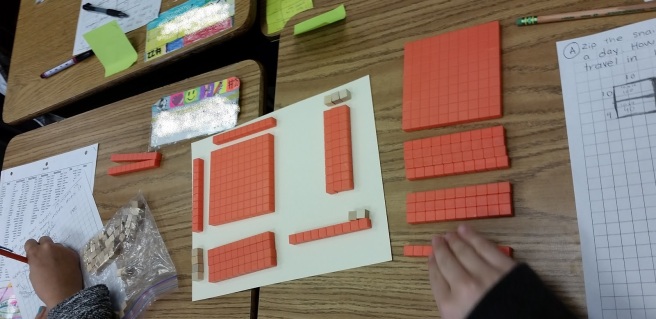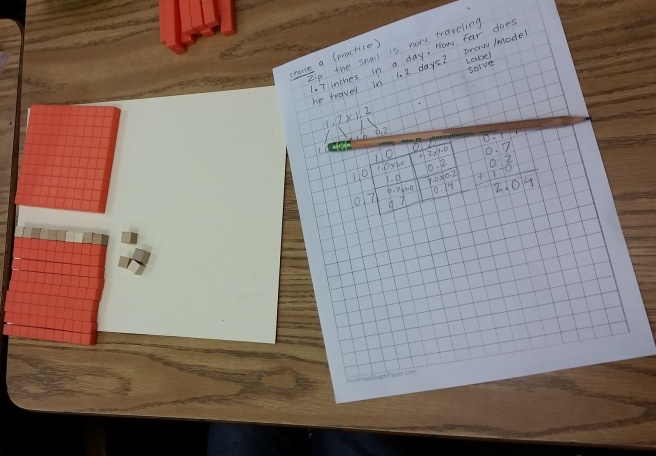I recently participated in a 5th grade lesson on multiplying decimals. The team had wanted to inquire about dividing fractions and decided this was the prior learning students were lacking to build a solid foundation. So a team of 6 of us spent a day researching standards, discussing the learning sequence, then collaboratively planning the lesson. With an expectation that we would all team teach, one brave teacher offered to lead the lesson in her classroom. She did the bulk of the hard work and we jumped in when we saw an opportunity for the perfect question. I was lucky that our support provider – a woman with wisdom and experience beyond my comprehension – was with us for this lesson since I’m still developing my proficiency in intermediate content. She pushed my thinking and what resulted from this 6 hour planning session was a lesson that blew all of our minds.
We began with what the students already know: the area model for multiplication with whole numbers. It was decided that students could draw an area model for a 2-digit by 2-digit problem, so we took it back one step and practiced building said model with base ten blocks. We prepared ourselves with questions that we could ask students while they worked on their models:
- How can we represent the area model with the base ten blocks?
- What’s the difference between this [concrete] model and the drawn model?
- What is the product? How do you know?
- What does the area model represent? Where is the 10, 3, [factors] etc?
- How much does this 1 unit represent? What is the value of the small cube?
- Is your value referring to the distance the snail traveled (inches) or how long it took (days)?
Students built their area models using the blocks and drew the representative area model on their paper. The idea was something like this:
Zip the snail travels 13in a day. How many inches does the snail travel in 14 days?
- Talk to your partner: What operation would you use to solve this?
- Each student draws & labels an area model.
- Students build their area model using concrete models.
Notice we never ask for the answer!
What we expected to see.
This student built a beautiful replica area model using concrete models.
Did this student understand the area model they were building? The fact that they put a rod & 2 cubes in the bottom right could mean many things. This is proof that, as Marilyn Burns says, “we learn so much from just stopping and listening to our students.” The question here is, “Why did you choose a rod and 2 cubes? What else could you have used to represent 12?”
Some observations we made during this part of the lesson included:
- Area models aren’t representational/to scale, so bringing in the blocks solidifies the value of the area.
- Do they need the scale model? To find out, go backwards and check for understanding by seeing if they can make the connection between the representation and the concrete model.
- Put both models (concrete & drawn) next to each other and do some contrastive analysis.
The day before, in preparation for this lesson, the teacher guided the students in redefining the place value blocks. If we rename a rod as “1”, how does that change the value of the unit cube? If we rename a flat as “1”, how does that change the value of the unit cube?
A quick shout-out to the teacher who has created a model-culture of Growth Mindset in her classroom. The children expressed excitement over challenging content knowing that it would grow their brains. Students know that if something is hard, they are about to learn something cool. Bravo!
At this point in the lesson, the teacher handed the students their next task:
Zip the snail travels 1.3in a day. How many inches does the snail travel in 1.4 days?
- Talk to your partner: What operation would you use to solve this?
- Students build their area model using concrete models.
- Discuss: Did the model change?
- Each student draws & labels an area model.
Note: It was so cool to see which students jumbled their blocks and started over and which ones worked with the model they already had in front of them. One group said, “I don’t understand what we’re supposed to do. We already did the model in the last problem.”
Again, what we expected to see.
In this example, the student has regrouped their blocks after creating the area model. You can clearly see the 2 wholes (including the ten tenths) and the 4 hundredths.
The line of questioning that followed developed students understanding of the relationship between the area models. I contend that the relationship would not have been made without the concrete model and the students’ ability to manipulate the blocks. There’s something about touching them while simultaneously saying, “Wait, what value is this one again?” It truly solidified the learning.
Some reflections from our debrief for this part of the lesson included:
- The teacher asked 5 pages of questions to guide students.
- Many students needed to be reminded of identity property when decimals were introduced (students wanted to say that 1 x .3 = 3).
- Do you need to line up the decimals with this model?
- In Kinder, when whole numbers were new, we gave them things to hold & touch. Now that decimals are new to them, they still need to hold & touch them!
- One student felt tricked because she thought the answer for both situations were the same because the digits in the product were the same. With a careful line of questioning from the teacher, she eventually came to her own conclusion that 182 inches & 1.82 inches are very different answers.
- Next time we need to consider including estimating for reasonableness.
- We need to keep asking, “What’s the value and why?”
Ultimately we wanted students to come to their own conclusion that:
The digits are the same, but they have changed place so the value has changed. We’ve changed the meaning of the flat from 100 to 1. If the digits are the same, do they have the same value?
Now don’t get ahead of yourself. No, not every student showed solid understanding. But another shout-out to the teacher. Right when the children started to reach their frustrational level, she gave them a prompt to consider, asked them to find a partner and the whole class took a lap around the field while they discussed. And many students DID show a solid grasp of the concept.
For practice, students were offered a choice of 2 problems. They could do 1 or both:
- Zip the snail is now traveling 1.7inches in a day. How far does he travel in 1.2 days?
- Zip the snail is now well rested and is traveling 2.3 inches in a day. How far does he travel in 1.4 days?
I would love to see this lesson lead to: How fast does a snail actually travel? And depending on how fast a snail actually travels, how accurate/inaccurate was our work today?
Another potential follow-up could be to provide an area model with no labels and ask, “What equation could the following model represent?” And then ask students to write a situation to go with their equation.
It may have been a hard lesson to plan & deliver (and it took a while for some of us adults to wrap our heads around!!) but I assure you the students will end up understanding the concept much quicker and for longer than if we had taught them the quick algorithm. Now when they relate this learning to the traditional algorithm, they’ll understand it and pick it up quickly. Many anti-common core folks rebut, “But the algorithm is faster!” I hope you can see from this lesson example how going slow and going deep actually does support our students in mathematical fluency and flexibility.






I like this blog very much so much great information.
LikeLike
Thank you!!
LikeLike